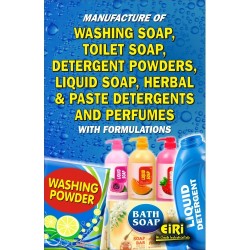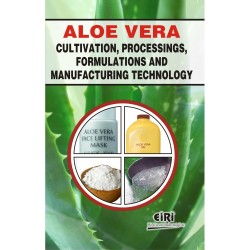synthetic resins technology with formulations (hand book)

- More than 40 years of experience
- Managed by expert industrial consultants
- ISO 9001-2015 Certified
- Registered under MSME, UAM No: DL01E0012000
- 24/5 Research Support
Get your quesries resolved from an industry expert. Ask your queries before report or book purchase. - Custom Research Service
Speak to the our consultant to design an exclusive study to serve your research needs. - Quality Assurance
All reports are prepared by highly qualified consultants & verified by a panel of experts. - Information Security
Your personal & confidential information is safe & secure.
SYNTHETIC RESINS TECHNOLOGY WITH FORMULATIONS
ALKYD RESINS
Introduction
Classification of Alkyd Resins
Drying
Non-Drying
Chemical Reaction
Manufacture
Fatty Acid Method
Fatty Acid oil Method
Oil dilution Method
Alcoholoysis Method
Fusion Versus solvent processing
General Processing and Design considerations
Choice of Construction Materials
Agitation
Removal of Unreached Resin Constituents
Administration of Inert Gas
Further Factors Influencing Plant Design
Reactor
Temperature and Time of Reaction
Reaction Control
Formulations for the Preparation of Alkyd Resin
Linseed Oil Pentaerythritol Alkyd Resin
Linseed Oil Glycerine Short Oil Varnish Alkyd
Soyabean Oil Alkyd Modified with Maleic Anhydride
Dehydrated Castor Oil-Propylene Glycol Alkyd
Soyabean oil Pentaerythitol Alkyd
Natural Resin Modified Alkyd
Non Drying Alkyd
Application of Alkyd Resins
White Architectural Enamel
Green Trim and Trellis Plant
Outside White House Plant
Traffic Paint
Four Hour Type Black Industrial Enamel
White Baking Enamel
White Marine Paint
Quick Drying Red Lead Primer
Emulsion Paints
Emulsification of Alkyd
ACRYLICS
Category of Acrylics
Unmodified Acrylics
Raw Materials
Methyl Methacrylate Monomer
Manufacture
Bulk Polymerisation
Solution Polymerisation
Suspension Polymerisation
Formulation
Emulsion Polymerisation
Laboratory Process of Emulsion Polymerisation
Applications
Acrylic Emulsion Paints
Gross Emulsion Paints
Acrylic Resin Emulsion Paint
Gross Emulsion Paints
Acrylic Resin Emulsion Paints
Exterior Paint Formulation with Rhoplex AC-34
Acrylic Emulsion Paint Formulation
High Quality Flat Wall Paints
Paint Formulation with Rhoplex
AC-33 and Rhoplex AC-55
Acrylic Emulsion Paint
Leather
Paper
Textiles
Advertising Signs and Displays
Lighting Fixtures
Architecture and Glazing
Plumbing Fixtures
Aircraft Enclosures
Lates Thickeners
Nonflammable Hydraulic Fluids
Viscous Flooding
Buildings
Suspending and Dispersing Agents
Petroleum Production
Metal Production
Flocculants
Clarification
Metallurgy
Soil Conditioning
Miscellaneous Applications
EPOXY RESINS
Introduction
Raw Materials
Epichlorohydrin
Bisphenol A
Curing Agents
Catalytically
Additives
Accelerators
Reactive Diluents
Plasticizers
Pigments and Fillers
Chemistry of Resinification
Types of Epoxy Resins
Low Viscosity Liquid Resins
Low Melt Viscosity Solid Resins
Epoxy Resins Systems for Operation at High Temperatures
Flame Retardent Epoxy Resins
Non-Glyciolyl-Ether Epoxy Resins
Cyclo Aliphatic Epoxy Resins
Acyclic Aliphatic Epoxy Resins
Epoxidised Polyolelins
Epoxydised Oils
Glycidyl Ethers of Bisphanol F and Dpoxy Novolak Resins
Manufacture
Laboratory Preparation of Dgeba
Commercial Preparation
Material Requirements
Applications
Adhesives
Modifiers for Epoxy Adhesives
Polyamides
Phenolics
Fillers
General Purpose Paste Adhesive
Fast Room Temperature Curing General Purpose Adhesive
Tough General Purpose Adhesive
Aircraft Adhesive
Patching Canking and Sealing Compounds
Stick Solder Adhesive
Canking and Glazing Compound
Concrete Floor Patch
Boat Patch Compound and Sealer
Organic Body Solder
Surface Coatings
Solvent Based System
Solventless (100% solid) System
Amine Cured Coatings
Ester Type Coatings
Heat Curing Finishes
Solventless Coatings
Powdered Coatings
Solution Coatings
Formulation
Epoxy Amine Coating Composition
Epoxy Phenolic Resin Gray Finish
Epoxy Phenolic Resin Gray Primers
100% Reactive Epoxy Coatings
Epoxy Polamide White Enamel
Epoxy Phenolic Primer Vehicles
Epoxy Phenolic Primer
Lamination
Potting
ION EXCHANGE RESINS
Introduction
Types of Ion-Exchange Resins
Strong Acid Resins
Weak Acid Resins
Strong Base Resins
Weak Base Anion Exchange Resins
Properties
Capacity
Swelling Equilibria
Ionic Equilibrium
Kinetics
Chemical Stability
Particle Form and Size
Physical Stability
Density
Bed Expansion
Applications
Water Softening
Water Delonization
Miscellaneous Applications
Chemical Conversion
Chemical Purification
Chemical Concentration
Ion Retardation
Acid Retardation
Catalysis
Ion Exclusion
Analytical Applications
Drying
Plant Nutrition
Manufacture
Basic Principles
Polymer Formation
Manufacture of Polystyrene Based ion exchange Resins
Polymerisation
Sulphonation
Chlorination and Animation
Alternative Method of Synthesis of an Anion Exchange Resin
Process of Manufacture
MELAMINE FORMALDEHYDE RESIN
Introduction
Raw Materials
Melamine
Chemistry of Resinification
Laboratory Preparation
Formulation
Procedure
Applications
Moulding Powders
Adhesives
Sources
Powdered Melamine Adhesives
Formulation
Laminating Resins
Surface Coatings
Formulations
Primer
Finish Coat
Paper Industry
Textile Finishes
PHENOL FORMALDEHYDE RESINS
Introduction
Raw Materials
Phenol
Formaldehyde
Hexamine
Chemistry of Resinification
Types of Phenolic Resins
Resols
Novolak
Equipment for Phenolic Resins
Manufacture
Reaction Kettle
Condenser
Heating Systems
Manufacture of Resols
Laboratory Preparation
Procedure
Commercial Preparation
Advance in Manufacture
Laboratory Preparation
Procedure
Commercial Preparation
Works Control Tests for Phenolic Resins
Melting Point
Viscosity of Resin Solution
Quality Control Tests for Phenolic Resins
Determination of Flow
The Curing Time
Free Phenol
Loss of Weight on Stoving at 135 Degree Centigrate
Stoving Time
Procedure
Properties
Phenolic Moulding Powders
Fillers
Primary Requirements
Secondary Requirements
Type of fillers
Wood Flour
Walnut Shell Flour
Cotton Flock
Modern Plastics Encyclopedia
Chopped Fabric
Twisted Cotton Cords or Strings
Mica
Diatomceous Silica
Asbestos
Mould Lubricant
Accelerators
Plasticizer
Colourants
Principles of Compounding
P.F. Wood Flour Mixture
Formulation for a Black Compound
Manufacture
Applications
Adhesives
Laboratory Preparation
Procedure
Commercial Preparation
Applications
Formulations
Phenolic Resin Putty
Phenolic Resin Rubber Cement
Coatings
Procedure
Formulations for Resin Modified Phenolic Resin Coating
Procedure
Bonding Resins
Friction Materials
Formulations
Brake Linings
Grinding Wheels and Coated Abrasives
Powdered Resin
Procedure
Processing
Coated Abrasives
Wood Particle Board or Wall Board
Insulation
Foundry Resins
Shell Moulding Process for Metal Casting
Sand Pre Coating Process
Dry Mix Process
POLYESTERS
Introduction
Classification
Unsaturated
Laminated and Casting Resins
Alkyds
Saturated
Raw Materials
Acid Constituents
Phinalic Acids
Isothalic acids
Adpic Acid
Sebacic Acid
Tetrachloro enolic acid
Saturated dibasic acids
Alcoholic Components
Propylene Glycol
Crosslinking Monomers
Styrene Monomer
Diallyl Phthalate monomer
Chemistry of condensation
Polyester Component
Monomer Component
Minor Component
Manufacture
Reaction Kettle
Healing System
Partial Condensder (Reflux Condenser)
Total Condenser
Blending or Thinning Tanks
Packing of the Product
Process Controls
Raw Materials Contro
Manufacturing Control
Final Product Control
Applications
Reinforcing Applications
Formulation for a General
Purpose Polyester Resin
Properties
Isophthalic Grade
Formulations
Properties
Malched Die Moulding
Mat or Preform Moulding
Premix Moulding
Application of Moulding Technique to Manufacture of Helmets
Laminating Applications
Fire Resistant Grade
General Purpose Grade
Processing Technique
Low Pressure Process
Moulding Powders
POLYVINYL ACETATE
Chemistry of Polymerization
Manufacturing
Laboratory Preparation of Polyvinyl Acetate
Procedure
Commercial Preparation
Special Techniques Continuous Processes
Applications
Paints & Coatings
Emulsion Paint Formulation (Gum Acacia Based)
Adhesives
General Purpose Adhesive
Quick Tack Polyvinyl Acetate
Emulsion Adhesive
Formulation for Highly Branched Polyvinyl Acetate Emulsion
Special Formulation of Polyvinyl Acetate Adhesive
Polyvinl Acetate Adhesive including cross Linking Agents
Other Synthetic Adhesives
Butadiene Copolymers
Latex Containing 2- Methyl-5 Vinylpyridine
Adhesive Composition Containing carboxylated Lates
Adhesive with Specific Functions
Pressure Sensitive Adhesive Formulations of Spontaneous Resin Emulsion
Emulsion for Pressure sensitive Adhesive
Formulation for Pressure sensitive Adhesive
Pressure Sensitive and contact Adhesive
Pressure Sensitive Acrylic Composition
Preparation
Textiles
Binders
Binder in incediary Composition
As Resin Binder
As Binder (Casts and Moulds)
As Hydraulic Binding Agent
Additive to Prevent Lime Staining
Additive to Cement
Miscellaneous Applications in Glass Fibre Treatment
Composition for Glass Fibres
in coating of foodstuffs
In wall Paper coating
In Miscellaneous Paper Adhesives as adhesives in the Building industry
In fireproof and water proof coatings
As sesame sealant
In Typewriter Bond
In Shoe Finishes
As Crack Filler
In Wood Coating
POLYVINYL ALCOHOL
Viscosities of Polyvinyl
Alcohol Solutions
Manufacture
Process of Manufacture
Compounding & Modifying Polyvinyl Alcohol
Plasticisers
Extenders
Insolubilizers
Precipitants and Gelling Agents
Pigments and Dyes
Wetting Agents
Anti Foaming Agents
Applications
Adhesives
Binders
Paper sizing
Paper Coatings
Textile Sizing and finishing
Emulsifying Agent
Polyvinyl Alcohol Films
Ceramics
Moulded Products
Protective Coatings
Cosmetics
PVC RESINS & PLASTISOLS
Introduction
Dispersion Resin Manufacture
Properties of the Dispersion Resin
Paste Forming Properties
Air Release
Gelation Properties
Fusion
Gloss and Clarity
Heat Stability
Compounding of Plastisols
Compounding Ingredients
Resins
Blending or Extending Resins
Thickners
Surfactants
Plasticizers
Heat Stabilizers
fillers
Pigments
Blowing Agents
Solvents and Diluents
Compounding for Specific Plastisol Properties
Viscosity
Hardness
Fusion and Gelation Temperature
Preparation of plastisols
Physical Properties
Low Temperature Flexibility
Gloss
Clarity
Heat Stability
Flame Retardance
Non Fogging
Formulations
Coating
Knife Coating
Strand Coating
Spray Coating
Formulations
Casting
Mould Casting
Slush and Rotational Moulding
Rotational Moulding
Slush Moulding
Dip Coating (Hot and Cold)
Cold Dip Coating
Foams
Chemically Blown Films
Chemically Blown Open
Cell Foam
Mechanically frothed Foam Open Cell Structure
Raw Materials
Bulk Handling
Storage
Mixing Equipment
High Speed Mixers
Paste & Dough Mixers
Paste & Dough Mixers
Other Type Mixers
Mixing Procedures
High Speed Low Viscosity
Organosols
Preparation of Dispersion Coatings
Formulation of Organosol Coatings
Primer for Lightly Plasticized Organosols
Crosslinked Primer for Organosols
Highly Cross linked Primer for Plastisols
Two Coat Organosol Topcoat
Striated Organosol
Spatter Finish Organosol
Pebble Textured Organosol
Thermoset Organosol
SILICONES
Introduction
Nomenclature
Processing Techniques for Silicone Elastomers
Manufacture of Silicones Fluids
Compounding
Fluids
Resins
Elastomers
Properties
Fluids
Resins
Elastomers
UREA FORMALDEHYDE RESIN
Introduction
Raw Materials
Urea
Thiourea
Chemistry of Resinfication
Equipment for Urea Formaldehyde
Resin Manufacture
Reaction Kettle
Condenser
Receiver
Heating Medium
Manufacturing Process
Laboratory Preparation
Procedure
Commercial Preparation
Applications
Adhesives
Laboratory Preparation
Procedure
Application
Commercial Preparation
Cold Glueing
Formulation
Hot Glueing
Chipboard Industry
Paper Industry
Surface Coatings
Moulding Powders
Pigments
Hardener
Stabilizer
Fillers
Cellulose Paper
Wood Flour
Other Fillers
Mould Release Agents
Plasticizer
Manufacture of Urea Moulding
Powder
Moulds
Process
Laminated Plastics
Miscellaneous Applications
Important Variable and their
control in the Manufacture of Moulding Powders
Purity of the Reagents
pH Control
Control of Reaction
Formulation of Moulding Powders
Urea Formaldehyde Moulding Powder
Properties of Moulding Powders
PROJECT PROFILES
Plant Economics of Phenol Formaldehyde Resin
Plant Economics of Poly Amide Resin
Plant Economics on Polyester resins
Plant Economics on Polycarbonate Resin
Plant Economics on Urea Formaldehyde Resin
Plant Economics on Acrylic Copolymer Emulsion
PRESENT MANUFACTURERS/DEALERS/SUPPLIERS OF SYNTHETIC RESINS
Resins Synthetic
Epoxy Resins
Melamine Formaldehyde Resins
Phenol Formaldehyde Resins
Urea formaldehyde Resins
Polyester Resins
Alkyd Resins
RAW MATERIAL SUPPLIERS
Acrylic Acid
Calcium Carbonate
Bulanol
Drier
Castor Oil Dehydrated
Dispesion Resins
Ethylene Glycol
Fumaric Acid
Glycerine
Iron Oxide (Red)
Linseed Oil
Methanol
Methyl Ethyl Ketone
Phthalic Anhydride
Pigment Binders
Polyols
Polyvinyl Acetate Emulsions
Polyvinyl Alcohol
Phenol
Starch
Soyabean Oil
Styrene
Titanium Dioxide
Toluene
Vinyl Acetate
Urea Melamine Formaldehyde Resins
Xylene Mixed
Zinc Oxide
Zinc Stearate
SUPPLIERS OF PLANT AND MACHINERY
Complete Plant Suppliers for Resins
Tanks (Storage and others) Condensor
Reactors
Ball Mill
Cooling Tower
HDPE Storage Vessels
Pumps
Boilers
Engineers India Research Institute (EIRI) is a renowned name in the industrial world for offering technical
and financial consultancy services.
EIRI services are:
Detailed Feasibility Reports
New Project Identification
Project Feasibility and Market Study
Identification of Lucrative Industrial Project Opportunities
Preparation of Project Profiles / Pre-Investment and Detailed Feasibility Studies,
Market Surveys / Studies, Market Survey Cum Detailed Techno-Economic Feasibility Reports
Project Reports in CD Roms
Identification of Plant /Process/Machinery and Equipment, Industrial General Guidance for setting up new
industrial projects.
Our most up-to-date and Technologically Advanced Industrial Project Reports, categorized with respect to
Financial Outlays and Sector – wise Classification are immensely useful for :
Existing Small or Medium Scale Industrialists facing competition from large houses
Young Entrepreneurs dreaming to start their own industrial enterprise
Young Graduates and Professionals wishing to begin their career
Industrialists interested in Debottlenecking their capacities & New Product – Lines
Large Industrial Houses pursuing Expansion, Growth and Diversification Plans
How to Make Project Report?
Detailed Project Report (DPR) includes Present Market Position and Expected Future Demand, Technology, Manufacturing Process, Investment Opportunity, Plant Economics and Project Financials. comprehensive analysis from industry covering detailed reporting and evaluates the position of the industry by providing insights to the SWOT analysis of the industry.
Each report include Plant Capacity, requirement of Land & Building, Plant & Machinery, Flow Sheet Diagram, Raw Materials detail with suppliers list, Total Capital Investment along with detailed calculation on Rate of Return, Break-Even Analysis and Profitability Analysis. The report also provides a birds eye view of the global industry with details on projected market size and then progresses to evaluate the industry in detail.
We can prepare detailed project report on any industry as per your requirement.
We can also modify the project capacity and project cost as per your requirement. If you are planning to start a business, contact us today.
Detailed Project Report (DPR) gives you access to decisive data such as:
- Market growth drivers
- Factors limiting market growth
- Current market trends
- Market structure
- Key highlights
Overview of key market forces propelling and restraining market growth:
- Up-to-date analyses of market trends and technological improvements
- Pin-point analyses of market competition dynamics to offer you a competitive edge major competitors
- An array of graphics, BEP analysis of major industry segments
- Detailed analyses of industry trends
- A well-defined technological growth with an impact-analysis
- A clear understanding of the competitive landscape and key product segments
Need Customized Project Report?
- Ask for FREE project related details with our consultant/industry expert.
- Share your specific research requirements for customized project report.
- Request for due diligence and consumer centric studies.
- Still haven't found what you're looking for? Speak to our Custom Research Team
About Engineers India Research Institute:
Note: We can also prepare project report on any subject based on your requirement and country. If you need, we can modify the project capacity and project cost based on your requirement.
Our Clients

Our Approach
- Our research reports comprehensively cover Indian markets (can be modified as per your country), present investigation, standpoint and gauge for a time of five years*.
- The market conjectures are produced on the premise of optional research and are cross-accepted through associations with the business players
- We use dependable wellsprings of data and databases. What's more, data from such sources is handled by us and incorporated into the report
Why buy EIRI reports?
- Our project reports include detailed analysis that help to get industry Present Market Position and Expected Future Demand.
- Offer real analysis driving variables for the business and most recent business sector patterns in the business
- This report comprehends the present status of the business by clarifying a complete SWOT examination and investigation of the interest supply circumstance
- Report gives investigation and top to bottom money related correlation of real players/competitors
- The report gives gauges of key parameters which foresees the business execution


































